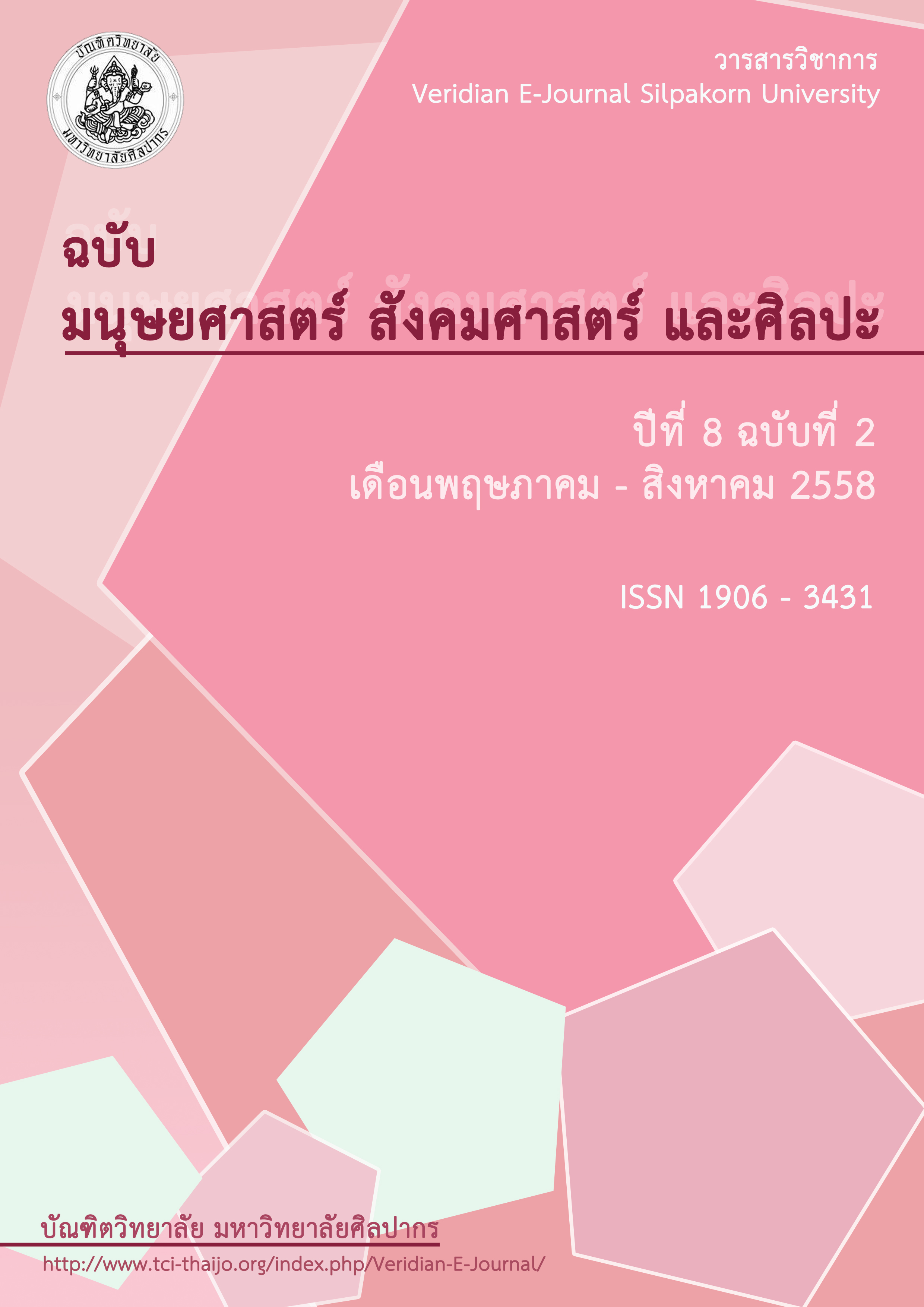การพัฒนารูปแบบการเรียนการสอนแบบผสมผสานด้วยกระบวนการเรียนรู้แบบ 4 MATเพื่อส่งเสริมความสามารถในการคิดวิเคราะห์และผลการเรียนรู้ของนักศึกษามหาวิทยาลัยราชภัฏ ที่มีความสามารถทางปัญญาต่างกัน
Main Article Content
Abstract
บทคัดย่อ
การวิจัยครั้งนี้มีวัตถุประสงค์ 1)เพื่อพัฒนารูปแบบการเรียนการสอนแบบผสมผสานด้วยกระบวนการเรียนรู้แบบ 4 MAT เพื่อส่งเสริมความสามารถในการคิดวิเคราะห์และผลการเรียนรู้ของนักศึกษามหาวิทยาลัยราชภัฏที่มีความสามารถทางปัญญาต่างกัน 2)เพื่อศึกษาประสิทธิผลของรูปแบบการเรียนการสอนแบบผสมผสานด้วยกระบวนการเรียนรู้แบบ 4 MAT เพื่อส่งเสริมความสามารถในการคิดวิเคราะห์และผลการเรียนรู้ของนักศึกษามหาวิทยาลัยราชภัฏที่มีความสามารถทางปัญญาต่างกัน 3)เพื่อรับรองรูปแบบการเรียนการสอนแบบผสมผสานด้วยกระบวนการเรียนรู้แบบ 4 MAT เพื่อส่งเสริมความสามารถในการคิดวิเคราะห์และผลการเรียนรู้ของนักศึกษามหาวิทยาลัยราชภัฏที่มีความสามารถทางปัญญาต่างกัน กลุ่มตัวอย่างที่ใช้ในการวิจัยเป็นนักศึกษาระดับปริญญาตรี มหาวิทยาลัยราชภัฏนครปฐม ที่ลงทะเบียนเรียนรายวิชา วิถีไทย ภาคการศึกษาที่ 2 ปีการศึกษา 2556 จำนวน 90 คน แบ่งเป็น 3 กลุ่ม ตามการจัดกลุ่มทางปัญญาตามแนวคิดของการ์ดเนอร์ (Gardner,1985) ดังนี้ 1)กลุ่มปัญญาที่เกี่ยวข้องกับสัญลักษณ์ 2)กลุ่มปัญญาที่เกี่ยวข้องกับบุคคล และ 3)กลุ่มปัญญาที่เกี่ยวข้องกับวัตถุ จำนวนกลุ่มละ30 คน ระยะเวลาในการทดลอง 10 สัปดาห์
ผลการวิจัยพบว่า
1. รูปแบบการเรียนการสอนแบบผสมผสาน(QSCCA Model) มีองค์ประกอบคือ ผู้สอน ผู้เรียน เนื้อหา ทรัพยากรการเรียนการสอน สภาพแวดล้อมการเรียนการสอนแบบผสมผสาน กระบวนการเรียนการสอนมี 5 ขั้นตอนคือ 1) สงสัย ใคร่รู้ (Learning to Question : Q) 2) สืบเสาะ ค้นคว้า(Learning to Search : S) 3) สื่อสาร สัมพันธ์ (Learning to Communicate : C) 4) สรุป สร้างความรู้ใหม่(Learning to Construct : C)สร้างสรรค์ ประยุกต์(Learning to Apply:A)โดยที่รูปแบบการเรียนการสอนแบบผสมผสาน(QSCCA Model) ที่พัฒนาขึ้นมีประสิทธิภาพเท่ากับ 83.70/86.84 ซึ่งสูงกว่าเกณฑ์ 80/80 ที่กำหนดไว้
2. หลังการเรียนโดยใช้รูปแบบการเรียนการสอนแบบผสมผสาน(QSCCA Model)นักศึกษาที่มีความสามารถทางปัญญาต่างกันทั้ง 3 กลุ่ม มีความสามารถในการคิดวิเคราะห์และผลการเรียนรู้แตกต่างกันอย่างไม่มีนัยสำคัญทางสถิติที่ระดับ .01 และความคิดเห็นของนักศึกษาที่มีต่อการเรียนการสอนโดยใช้รูปแบบการเรียนการสอนแบบผสมผสาน(QSCCA Model) มีความคิดเห็นอยู่ในระดับเห็นด้วยมากที่สุด
คำสำคัญ : การเรียนการสอนแบบผสมผสาน/การคิดวิเคราะห์/กระบวนการเรียนรู้แบบ 4 MAT/ความสามารถทางปัญญา
Abstract
The purposes of this research were : 1) to develop the blended learning instructional model by using 4 MAT system to enhance creative analytical thinking ability of Rajabhat University students’ multiple intelligences, 2) to study the efficiency and implement of the blended learning instructional model, and 3) to verify the blended learning instructional model. The samples were 90 undergraduate students from Nakhon Pathom Rajabhat University, who took Thai Living course, during the second semester of 2013 academic year. They were selected by using random stratified sampling technique and utilizes Gardner’s theory of multiple intelligences(Gardner,1985),and assigned as symbol-based intelligence group (n=30),human-based intelligence group (n=30),and object-based intelligence group (n=30) .The experiment duration were 10 weeks.
The research findings were as the following:
1. The blended learning instructional model by using 4 MAT system to enhance creative analytical thinking ability of Rajabhat University students’ multiple intelligences or QSCCA Model consisted of 5 components: 1) instructor, 2) learners, 3) content, 4) learning management system, and 5) learning resources. There were 5 steps of learning process: 1) learning to question; Q, 2) learning to search;S, 3) learning to communicate ; C, 4) learning to construct ; C, and 5) learning to apply ; A.
2.The creative analytical thinking ability and the learning achievement of the three groups multiple intelligences students’ after using the blended learning instructional model were not statistically different at the .01 level. The students’ opinions toward the blended learning instructional model at the highest level.
Keywords : Blended learning instructional model/ Creative analytical thinking/4 MAT system/ multiple intelligences
